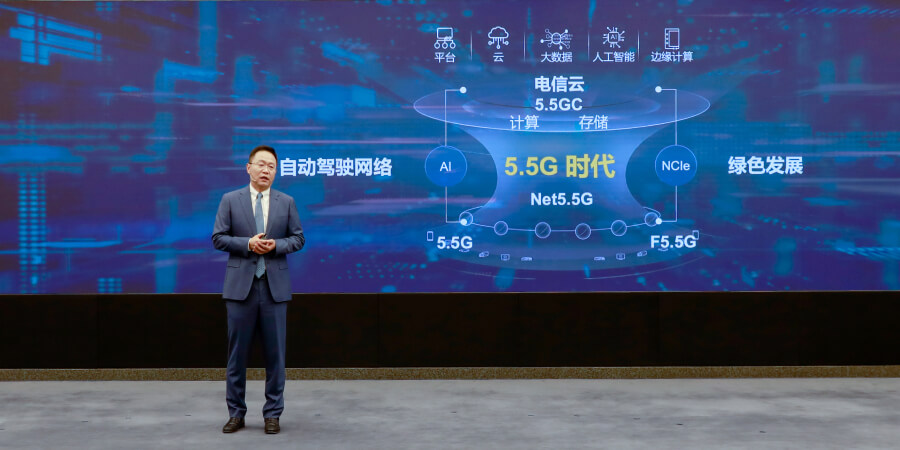In the past, Huawei has shared ideas about the generation evolution of fixed mobile technologies in the hope that they can point to the direction of the industry development while pursuing better experiences and showcasing a pioneering spirit.
As part of the Win-Win Huawei Innovation Week 2022, David Wang, Executive Director of the Board and Chairman of the ICT Infrastructure Managing Board of Huawei, discussed the continuous innovation lining up in the 5.5G era. Facing 2025, there will be both very diverse and very demanding requirements coupled with major market potentials and opportunities, and with this, Huawei will evolve to meet the 5.5G era.
“We hope that Huawei will continue to serve home based, individual and enterprise users with the following focuses, and that the ICT industry, at large, can achieve the vision of a greener and more intelligent future,” Wang stated.
10 Gbps speed. For wireless, 10 Gbps will be achieved through a wider spectrum bandwidth, higher spectrum efficiency and higher order MIMO. Huawei aims to use 6G and mmWave bands, a higher order modulation mode of 1024 QAM, and an extremely larger antenna array (ELAA) to improve the speed.
Over the past two decades, fiber has gone from roadsides to buildings to homes, and this technology will extend to every room (FTTR) in the next 10 years. 50G PON has also made an encouraging technological breakthrough by supporting 50 Gbps PON access at a 20-km range. This further supports dense timeslots and low latency for carriers developing B2B optical transformation. The next step is 800G and optical switching where the backbone network changes to a 3D mesh to bypass network congestion, and a three-in-one optical service achieves millisecond-level latency.
“Exploring the evolving direction of the datacom industry, we are proposing Net5.5G for the first time. As enterprise digital transformation becomes the trend, IPv6 provides network programmability and real-time status awareness, helping enterprises jump to the cloud. We believe that IPv6 will be the most fundamental technology for the datacom industry in the next decade,” Wang highlighted.
Beyond connectivity. 4G brought us into the IoT era while 5G is enabling a wide range of industries. For 5.5G, connectivity will expand to enable sensing and bring new scenarios and applications to life. And with regard to fiber sensing, the vibration, temperature, stress and pressure sensing can all be combined with intelligent management and analysis capabilities such as big data, AI and GIS.
From connectivity to service enablement – and in order to support the enterprise VPN – UFP/MEC must be deployed to provision hundreds of private networks and deliver 10x faster speeds on a wide target area. In parallel, the future telco cloud will support both virtual machines and containers, delivering six-nine reliability. The passive cellular IoT technology will also see a bigger market, valued at up to $100 billion with the NB-IoT continuing to evolve within the 5G and 5.5G eras.
10x effective computing. “In the 5.5G era, there are three things needed to achieve diversified computing and improve effective computing power by 10x,” Wang remarked. First is adopting new architecture to make data centers evolve and become a computer in and of themselves (DC-as-a-computer), this is followed by transforming computing node architecture from being CPU-oriented to a peer-to-peer architecture.
10x storage performance. Storage performance should be improved by 10x as data is being created, processed and transferred continuously. “In the 5.5G era, storage will be the data infrastructure for diverse data sources and applications,” Wang indicated. The flow of the data transmission needs to go through PCIe and DDR and, in the future, these two conduits will converge, improving data transmission efficiency. The architecture redefinition will reduce the IOps latency from 100 microseconds to 10 microseconds, and the acceleration engine will further bring data processing closer to applications
High-level autonomy. Huawei was the first to introduce the concept of ADN in 2018. With this, the telecom industry is anticipated to benchmark ADN in making O&M an autonomous process. “AI-native will provide user experiences with zero wait, zero fault and zero contact, while network operators can enjoy self-configuration, self-repairing and self-optimization capabilities,” Wang explained. Huawei has dynamically compressed and stored over 80,000 KPIs and has experience in maintaining over 3,000 networks, a capacity which has made its self-learning network deliver 93.5% accuracy in unknown fault identification and association.
Green development. Huawei’s philosophy is to deliver more bits with less watts. Improving network energy efficiency is done by reducing the energy consumption per bit. The industry can benefit from adopting the ITU-T accepted unified KPI system known as the network carbon intensity energy (NCIe) which can be used to assess and devise the energy-saving policy for the entire network. Huawei also have a three-layer architecture solution — green operation, green network and green site — to accelerate the green development of the ICT industry in 2025.
Under the framework of 3GPP, ETSI and ITU, other specific technological evolution paths can be defined. Coming to a conclusion, Wang expressed, “We look forward to working with operators, partners, and other telecom players to accelerate and increase our efforts in providing the right network. Let’s put our heads together and evolve into the 5.5G era, enjoying an innovative future with shared success!”










